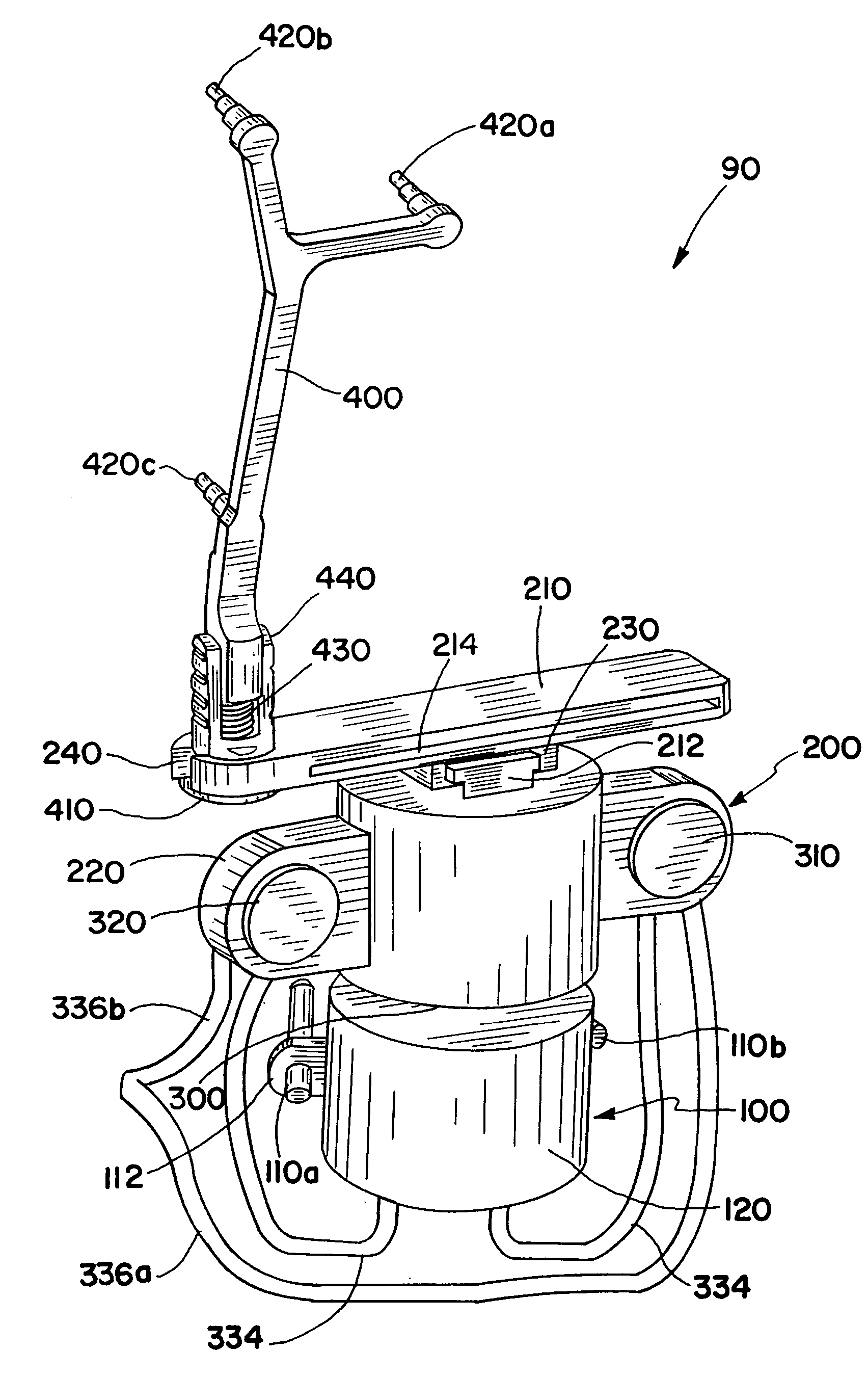Adjustable treatment aid for treating bones
a treatment aid and adjustment technology, applied in the field of guiding and/or positioning a bone treatment tool, can solve the problem of difficulty in maintaining the precise position of the incision block
- Summary
- Abstract
- Description
- Claims
- Application Information
AI Technical Summary
Benefits of technology
Problems solved by technology
Method used
Image
Examples
second embodiment
[0052]FIGS. 5a and 5b illustrate the treatment aid 91 in accordance with the invention. FIG. 5a illustrates a view of the treatment aid 91 from the surgeon's point of view, e.g, a front view, while FIG. 5b illustrates a view of the treatment device a surgeon would not see, e.g., a back view.
[0053] As opposed to the first embodiment, the second embodiment 91 operates mechanically, instead of pneumatically. More specifically, elastically formed elements serve to fix the relative position between the first and second frames and, in particular, to secure the first and second frames as an external force is applied to the frames.
[0054] A first frame 120 includes openings 122 through which positioning pins can be guided to connect the first frame to the bone. First and second setting wheels 312, 314 can be used to provide a rotational force to first and second threaded rods, respectively (the second threaded rod 315 corresponds to the second setting wheel 314, while the first threaded rod...
third embodiment
[0062]FIG. 8 illustrates the treatment aid 94, which uses a self-locking gear, such as a worm gear, for example, to adjust the rotational axes. A first worm gear 392 is activated by the first setting wheel 312 and a second worm gear 394 is activated by the second setting wheel 314. The worm gears 392, 394 are mounted to a bearing (not shown), which is connected and positionally fixed to the second frame 200. The first and second worm gears 392, 394 each mate with a first and second gear wheel, wherein only the second gear wheel 336 is shown. The axes of the gear wheels are arranged at a 90 degree angle to the axes of the worm gears. The gear wheels cause a rotation about a first rotational axis 337 and about a second rotational axis (not shown), each of which runs perpendicular to the axis of the respectively assigned worm gear. This again achieves the desired two rotational degrees of freedom of adjustment.
[0063] With further reference to FIG. 9, the adjusting device responsible fo...
fourth embodiment
[0064]FIGS. 10 and 11 show the treatment aid 95. In this embodiment, one setting wheel 315 is utilized to rotate the interface 230 and, therefore, the treatment block or tool about two rotational axes.
[0065] The interface 230 can be formed as a plate-like structure, e.g. a round plate having a flat surface, and the first setting wheel 315 can be connected to a first side 230a of the interface 230 via a joint connection 372. A second side 230b of the interface 230, preferably a side opposite the first side 230a, can be connected to a threaded rod 376 via a joint connection 374. The first setting wheel 315 can have an inner thread which meshes or otherwise interfaces with an outer thread of the threaded rod 376. As the first setting wheel 315 is rotated, it travels along the rod 376. As the first setting wheel 315 moves toward the interface 230, the interface 230 is increasingly inclined via the joint connection 372. Simultaneously, the interface 230, by virtue of the joint connection...
PUM
 Login to View More
Login to View More Abstract
Description
Claims
Application Information
 Login to View More
Login to View More - R&D
- Intellectual Property
- Life Sciences
- Materials
- Tech Scout
- Unparalleled Data Quality
- Higher Quality Content
- 60% Fewer Hallucinations
Browse by: Latest US Patents, China's latest patents, Technical Efficacy Thesaurus, Application Domain, Technology Topic, Popular Technical Reports.
© 2025 PatSnap. All rights reserved.Legal|Privacy policy|Modern Slavery Act Transparency Statement|Sitemap|About US| Contact US: help@patsnap.com



